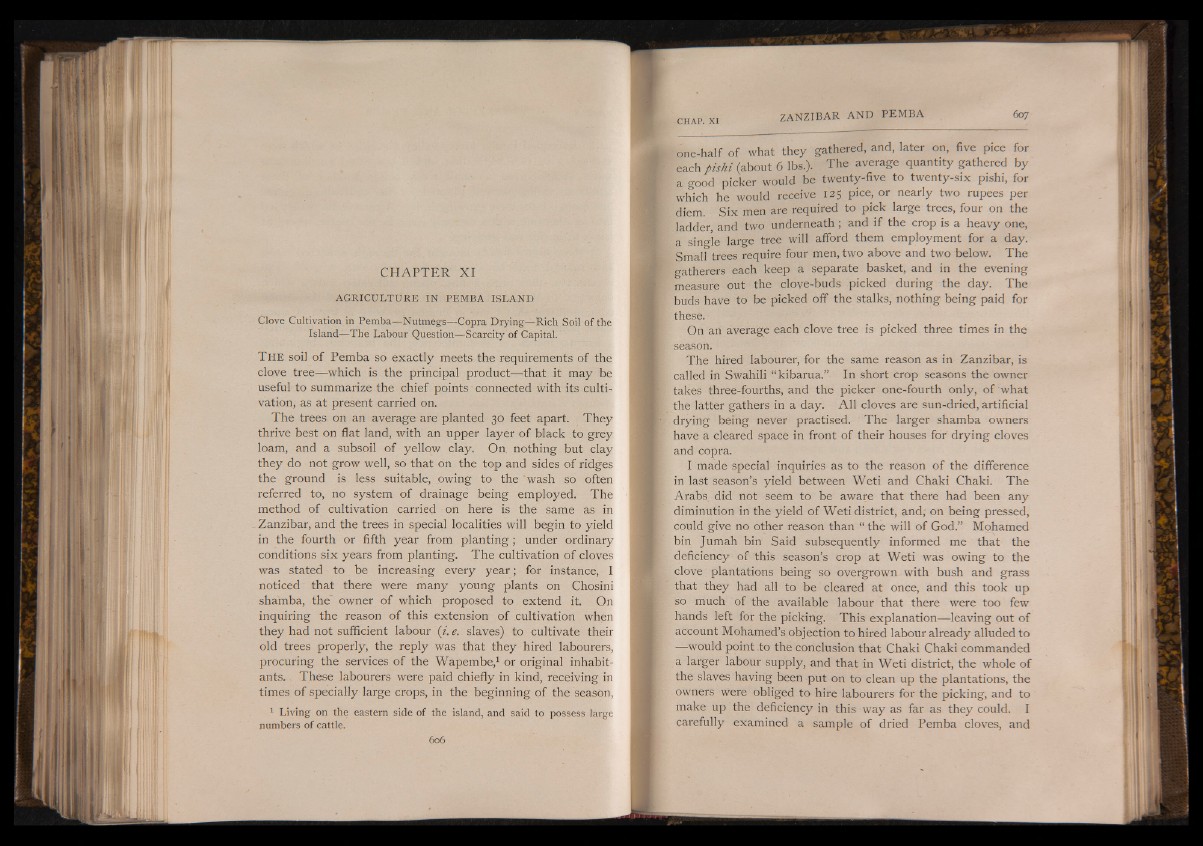
CH APTER XI
AGRICULTURE IN PEMBA ISLAND
Clove Cultivation in Pemba— Nutmegs— Copra Drying— Rich Soil of the
Island— The Labour Question— Scarcity of Capital.
T he soil of Pemba so exactly meets the requirements of the
clove tree— which is the principal product— that it may be
useful to summarize the chief points connected with its cultivation,
as at present carried on.
The trees on an average are planted 30 feet apart. They
thrive best on flat land, with an upper layer of black to grey
loam, and a subsoil of yellow clay. On nothing but clay
they do not grow well, so that on the top and sides of ridges
the ground is less suitable, „owing to the 'wash so often
referred to, no system of drainage being employed. The
method of cultivation carried on here is the same as in
Zanzibar, and the trees in special localities will begin to yield
in the fourth or fifth year from planting; under ordinary
conditions six years from planting. The cultivation of cloves
was stated to be increasing every year; for instance, I
noticed that there were many young plants on Chosini
shamba, the owner of which proposed to extend it. On
inquiring the reason of this extension of cultivation when
they had not sufficient labour (i. e. slaves) to cultivate their
old trees properly, the reply was that they hired labourers,
procuring the services of the Wapembe,1 or original inhabitants.
These labourers were paid chiefly in kind, receiving in
times of specially large crops, in the beginning of the season,
1 Living on the eastern side of the island, and said to possess large
numbers of cattle.
one-half of what they gathered, and, later on, five pice for
each pishi (about 6 lbs.). The average quantity gathered by
a good picker would be twenty-five to twenty-six pishi, for
which he would receive 125 pice, or nearly two rupees per
diem. Six men are required to pick large trees, four on the
ladder and two underneath; and if the crop is a heavy one,
a single large tree will afford them employment for a day.
Small trees require four men, two above and two below. The
gatherers each keep a separate basket, and in the evening
measure out the cloye-buds picked during the day. The
buds have to be picked off the stalks, nothing being paid for
these.
On an average each clove tree is picked three times in the
season.
The hired labourer, for the same reason as in Zanzibar, is
called in Swahili “ kibarua.” In short crop seasons the owner
takes three-fourths, and the picker one-fourth only, of what
the latter gathers in a day. All cloves are sun-dried, artificial
drying being never practised. The larger shamba owners
have a cleared space in front of their houses for drying cloves
and copra.
I made special inquiries as to the reason of the difference
in last season’s yield between Weti and Chaki Chaki. The
Arabs did not seem to be aware that there had been any
diminution in the yield of Weti district, and; on being pressed,
could give no other reason than “ the will of God.” Mohamed
bin Jumah bin Said subsequently informed me that the
deficiency of this season’s crop at Weti was owing to the
clove plantations being so overgrown with bush and grass
that they had all to be cleared at once, and this took up
so much of the available labour that there were too few
hands left for the picking. This explanation— leaving out of
account Mohamed’s objection to hired labour already alluded to
— would point to the conclusion that Chaki Chaki commanded
a larger labour supply, and that in Weti district, the whole of
the slaves having been put on to clean up the plantations, the
owners were obliged to hire labourers for the picking, and to
make up the deficiency in this way as far as they could. I
carefully examined a sample of dried Pemba cloves, and